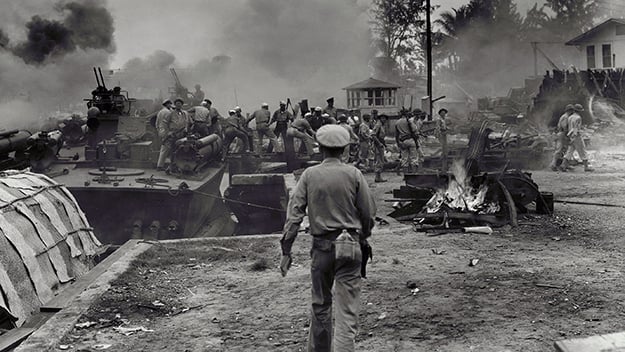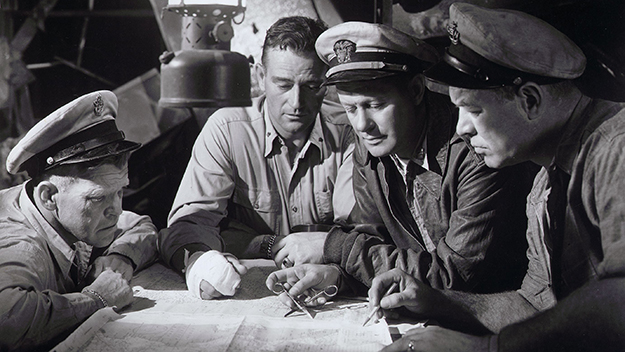TCM Diary: They Were Expendable

Images from They Were Expendable (John Ford, 1945)
Theirs not to reason why,
Theirs but to do and die.
—Alfred, Lord Tennyson, “The Charge of the Light Brigade”
Over and over again in John Ford’s gloomy, beautiful They Were Expendable, characters are told that no help is coming, no one will save them, they are on their own. The gigantic American war machine is in retreat, as one by one the islands of the Philippines are seized by the Japanese, leaving people stranded with no way out. In an increasingly dire situation, the characters stand, looking to the skies, looking out to sea, hoping for intervention from the Air Force, from a fleet of battleships, hoping that they aren’t, in fact, “expendable.” In a military context, “expendable” refers to supplies or equipment that can be sacrificed in the pursuit of a larger goal. But over the course of They Were Expendable, one of the greatest war films ever made, it’s people who are “expendable.” It’s right there in the title. There’s nothing to be done about it. Soldiers understand it. It’s war. Thank you for your service.
In 1942, William L. White published They Were Expendable: An American Torpedo Boat Squadron in the U.S. Retreat from the Philippines, detailing the exploits of PT boat squadrons in the Pacific, under the leadership of Lieutenants John Bulkeley and Robert Kelly. The PT boats were, by all accounts, underestimated by the higher-ups, especially when compared to American battleships and destroyers. But Pearl Harbor showed the vulnerability of battleships. When General Douglas MacArthur had to be evacuated from Corregidor Island in February 1942, ahead of the Japanese advance, it was a PT boat that ushered him to safety at Mindanao, where he was then airlifted to Australia. MGM bought the rights to White’s book and offered it to John Ford, who was serving in the Navy with his own film group under the umbrella of the OSS. It took some time to get the film into production (in February 1945), and by then the situation in the Pacific had changed. Many of the people involved in They Were Expendable, in front of the camera and behind, had completed their tours, and their ranks and branches are listed alongside their names in the credits (a nice touch).
Robert Montgomery stars as Lt. John Brickley, bringing to bear his real-life experiences as a PT boat commander in an extremely authentic performance. John Wayne (who, famously and infamously, did not serve) plays Lt. “Rusty” Ryan, Brickley’s second-in-command, anxious to get assigned to a destroyer (that is, until he sees what the PT boats can do). With a screenplay by Frank Wead (“Cmdr USN – ret”), They Were Expendable starts in Manila Bay in 1941, when news of the bombing of Pearl Harbor interrupts a party. Brickley, eager to get his PT boats into the action, is frustrated when they are given an intra-island messenger service detail. An officer’s comment expresses the general attitude: “Those boats of yours maneuver beautifully, but in wartime I’m afraid I believe in something more substantial.”
Brickley and his men eventually prove the worth (and superiority) of PT boats, in a series of successful raids on Japanese destroyers, but the mood overall is so grim, the situation so catastrophic, there’s no emotional space to revel in triumph. They Were Expendable is a series of retreats as the islands are overrun. The squadron’s base is destroyed. Supply lines are cut off. Running out of food and ammo, the men are sitting ducks. Some of the sailors look like they were airlifted out of their sophomore geometry class directly to the field of battle. Ford’s sentimental tendencies are nowhere in evidence; They Were Expendable is the opposite of misty-eyed.

During Rusty’s short stay in the makeshift hospital after being wounded, he takes a shine to nurse Sandy Davyss (Donna Reed). Their romance barely gets off the ground before the fall of Bataan, and the two are separated. At the end of the film Sandy’s fate remains unknown, a realistic choice. Women were sometimes “symbolic” of the home front, of “what we are fighting for,” but Sandy is in the fight, just as at risk as the men around her, and just as brave. They Were Expendable is the kind of film where all you have to do is scan the faces of everyone on screen—the stars, the co-stars and the extras—to see the stakes of war. There is a kind of lived-in gravitas that can’t be manufactured. Montgomery has never been better, most notably in the speech he makes to his men who have been sent to join the Army in Bataan: “You older men with longer service records, take care of the kids. Maybe… That’s all. God bless you.” It’s the opposite of a rousing speech, but it’s filled with feeling, particularly the long pause after “Maybe,” where he chooses not to continue. No room for “Maybe” in wartime, and he knows it.
Joseph August, who had served with Ford, shot the film, and it’s a moody piece of work, sometimes bordering on the expressionistic. There are so many scenes of men huddled over maps in shadowy spaces too small to fit all of them, men walking back and forth through the hallway leading in and out of the hospital, their figures stark black silhouettes, hunched with responsibility, dread, awareness. August’s tactile approach gives They Were Expendable an emotional immediacy, a palpable sense of place (extraordinary when you consider it was shot in Key Biscayne, Florida), from the palm trees waving in the sunlit glare to the inky-black shadows cutting across people’s faces at night. In his 1946 review of the film, James Agee wrote, in his classically plainspoken way: “All you have to watch is men getting on or off PT boats, and other men watching them do so. But this is made so beautiful and so real that I could not feel one foot of the film was wasted.” When I think of They Were Expendable, the first thing I think of is—to quote Scott Eyman from his wonderful biography of John Wayne—all those “shots of long, dark corridors peopled by small groups of grieving men.”
They Were Expendable was released on December 7, 1945, the fourth anniversary of the attack on Pearl Harbor. The war had just ended in September, and although the film got excellent reviews, it wasn’t a hit at the box office. Maybe the reality of what the men (and boys) returning home had suffered was too grim. Maybe the title was too bleak or cynical for those who were grieving. Unlike many other WWII films, which have to be viewed in the prevailing context of wartime America, They Were Expendable hasn’t “dated” at all. There’s nothing even remotely “jingoistic” about it. It ends with a devastating scene where two men are bumped off the last plane out to make room for two PT boat commanders. As one of these men exits the plane, he asks Rusty to call his wife for him: “Tell her you saw me, and that I still love her.” “You bet I will.” The film’s message of war is a realistic one. Heroism exists, but it’s heroism covered in bandages, it’s heroism walking with a limp. Heroism is a group of men standing on a dock, squinting up at an empty sky.
Sheila O’Malley is a regular film critic for Rogerebert.com and other outlets including The Criterion Collection. Her blog is The Sheila Variations.







